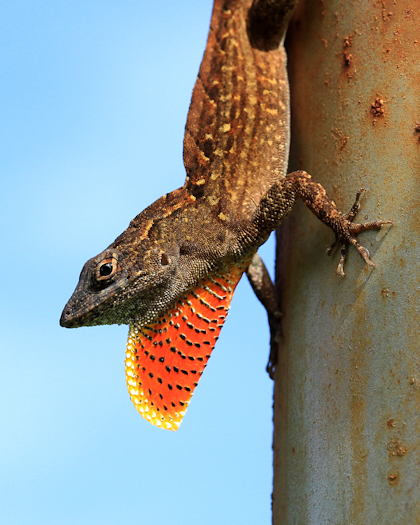Over the last decade the term “model species” has taken on new meaning. Species that were once the building blocks for distinct disciplines have taken on new importance in comparative evolutionary studies that integrate perspectives across biological disciplines. Nowhere is this better illustrated than with Anolis lizards. For decades anoles were a workhorse of ecologists and evolutionary biologists, but have, more recently, been embraced by developmental biologists, genomicists, physiologists, and neurobiologists among others. This disciplinary expansion is perhaps most evident with the rapid increase of penis/hemipenis research that has been published using anoles within the year.
For many herpetologists, including those focused on anoles, the hemipenis is ripe with taxonomic characters, easily allowing for the identification of new species. Julia Klaczko and colleagues recently demonstrated that features of the hemipenis are some of the most rapidly evolving characters among anoles, a group already well known for its rapid anatomical evolution. Independent from these taxon-specific interests, developmental biologists became interested in the anole hemipenis because of its unique anatomy compared to other amniotes. Marissa Gredler and members of the Cohn Lab used anoles as one of their reptilian models of external genital development in what is arguably the broadest embryological survey of reptilian phallus development to date. In parallel, Patrick Tschopp and colleagues probed the cellular and molecular regulation of early phallus development among anoles, snakes, chickens and mice, demonstrating that the hemiphalluses (hemipenes and hemiclitores) and hindlimbs of squamates utilize similar molecular networks at the earliest embryonic stages of morphogenesis. Now, just within the last month, two more papers have used anoles in studies of phallus evolution and development, one using cutting-edge molecular techniques to better understand the relationship between limbs and external genitalia and the other addressing the fundamental question of external genital homology using museum specimens that are more than 100 years old.
Before getting into the findings of this new research, lets lay out some of the dirty details of penis evolution. First and foremost, the penises of amniotes are extremely diverse. Squamates have paired lateral phalluses while other clades have a single midline phallus. Each of the amniote lineages uses hydrostatic pressure to achieve an erection, yet accomplish this using different bodily fluids (lymph or blood). In mammals sperm is transferred to the female through a closed urethral tube, but other groups utilize an open channel. Most birds (97%) and the tuatara, have absent or highly reduced phalluses and reproduce with the famed “cloacal kiss.” These large differences in anatomy should not overshadow the spines, bulges, corkscrews, and dramatic differences in size that give species their distinctive features. But with such striking variation, we are forced to wonder how many times the penis evolved. Perhaps the amniote ancestor possessed an intromittent phallus capable to transferring sperm to the female that later diversified in each lineage independently. Or, perhaps the last common amniote ancestor used cloacal apposition to foster internal fertilization and unique phallus morphologies evolved independently at the origin of each lineage. Because adult anatomy provides few clues to phallus homology, Thom Sanger (me), Marissa Gredler, and Marty Cohn looked towards the embryo for help.

Table 1 from Sanger et al. 2015 summarizing phallus variation in amniotes
The tuatara, a species lacking an adult phallus, has presented a problem in attempts to reconstruct the last common ancestor of amniotes because it raises the distinct possibility that reproduction through cloacal apposition was the ancestral condition.









